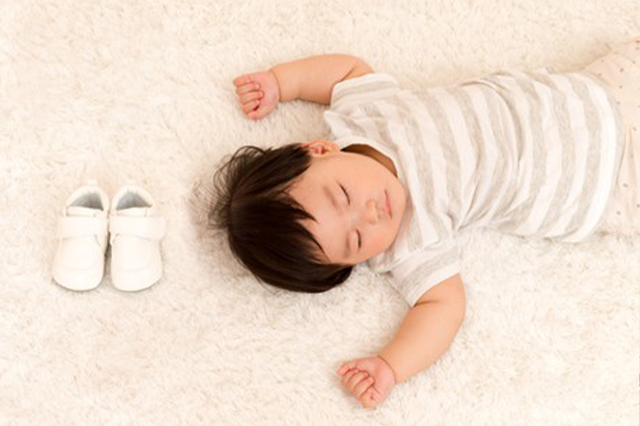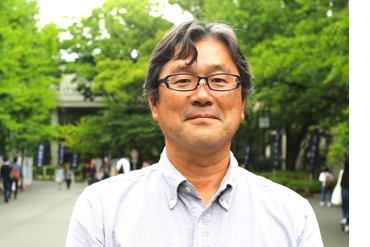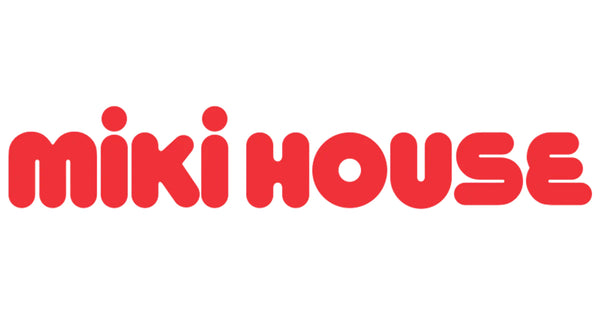Hear from the Experts:
How to choose the right pre-shoes for your baby’s growing feet
The choice of shoes is important that it affects the way the person walks or the posture, and the same is true for babies who are just starting to walk. As a mother and father, you want to make sure that you choose the “right shoes” for your baby.

As Leonard Da Vinci once said, “The human foot is a masterpiece of ergonomics and a work of art,” human babies start to stand up and walk using this “ergonomic masterpieces” only a year after birth. What is the shoe that does not interfere with the movement of the human foot that makes it a “masterpiece”?
We conducted a two-part interview with Dr. Takashi Kawabata of the Faculty of Human Health Department at Kansai University who is a shoe expert and studies walking from a scientific point of view. In the first part, we will introduce the development of a baby’s feet from birth to about a year old, and the pre-shoes that you should put on your baby when they start to walk.
There is no need to force your baby to walk. The basic idea is to let nature take its course without rushing too much.

Mothers and fathers are filled with love when they see the little legs peeking out from the hem of the baby clothes. The shape of a baby’s feet is quite different from that of an adult’s, as they become plump and round around three months of age. How do babies’ feet develop and grow to be able to step on the earth, walk, and run?
Dr. Kawabata of Faculty of Human Health says this:
“Let’s start by talking about “bone growth.” It is not widely known, but bone growth doesn’t mean that the ends of the bones are growing. The bones grow by taking nutrients into the cartilage tissue, called the “epiphyseal cartilage plate (growth plate),” which is a gap in the bones. Of course, this growth plate exists in babies’ feet, but this plate is very weak. So, if you put too much pressure on your baby’s feet, the feet can become deformed. If mothers and fathers are so excited about their baby’s growth that they try to force the baby to stand or walk quickly, it may have a negative effect on the growth of the bones in the legs. So, please take your time and let nature take its course.” (Dr. Kawabata)

When hearing things like “my child stood up at 10 months of age” or “my child started walking before becoming a year old,” new mothers and fathers who have babies around the same age who have not yet graduated from crawling may feel a little bit nervous, but there are no worries at all. It is normal for growth to vary from person to person, and slow and deliberate growth may produce better results for later growth.
According to the doctor, it is essential for babies to crawl sufficiently in order to be able to walk well. By crawling sufficiently, their upper bodies, including the abdominal muscles, back muscles, and arm muscles, strengthen and help develop a sense of balance and reflexes.
“Once babies start walking, they rarely crawl anymore, so it is important that they have good upper body strength during the crawling period. In fact, children who have been crawling for a long time have a more stable gait and are less likely to fall.” (Dr. Kawabata)

Also, the reason why babies’ legs are curved, and their knees point outward, giving them the bowlegs, is because the connection point between the pelvis and femur is not yet developed. By early elementary school age, the knees will face forward and the heel bones and tibia (shin bone) are connected in a straight line.
Shoes for babies and growing children are important because they are not fully developed. The “growth plates” of the bones disappear and stop growing between the ages of 15 and 18. In other words, this is the “exit point” of the growth period. Parents should know the “exit image of their child’s growth” and guide them to walk on two legs correctly. If the bones are deformed while hardened, it will affect the skeleton and body movements.” (Dr. Kawabata)
Dr. Kawabata said that once your child starts walking after crawling for a long time, the next step is to let your child walk barefoot. He explained the reason for this by citing the “role of heels and soles.”
“The bones of the human heel are well developed than those of other animals because the anti-gravity structure of the two legs is supporting the entire body weight. The soles of the feet are the only part of the human body that is in constant contact with the ground or floor when standing, so they have developed senses to gather various information. Babies develop a sense of equilibrium when their cerebrum is stimulated by the pressure sensation (the feeling of being pressed against) transmitted through the soles of their feet, so it is preferable to have them walk barefoot to get more direct pressure sensation.” (Dr. Kawabata)

The sense of equilibrium, which is necessary for walking and moving while maintaining balance, functions properly when three senses are combined: the senses in the soles of the feet, the information seen by the eyes, and the senses in the inner ear. The soles of a baby’s feet are covered with fat and are unstable when they first start to stand up, but they start to grip the ground with their middle, ring, and little toes little by little, which helps them to walk more steadily.
Practice crawling wearing Pre-Walking Shoes
When babies start to walk, they will probably spend most of the time indoors. It is more ideal to practice walking barefoot, but it is also a good idea to start practicing walking with pre-shoes that are similar to barefoot shoes for when they actually start walking outside.

“In general, it is the best time to try on pre-shoes when your child starts walking and grabbing. However, as I mentioned earlier, this is still the time when you want your baby to experience a lot of barefoot. Therefore, it does not make sense to wear shoes that do not properly support the growth of their feet.” (Dr. Kawabata)
Yes, he is right. So, what do you need to be careful about when choosing pre-shoes? Dr. Kawabata points out the following:
“The first thing to look for is how well it fits the baby’s feet. You should actually put them on and check that the heel is snug and that the ankle and instep are properly secured. Also, it is recommended to wear shoes with toes that are shaped to fit the baby’s feet and with adequate room for the toes so that they can move their toes freely and have the feeling of walking while gripping the ground with their toes. In order to feel a lot of information from the back of the feet, it is ideal that the sole has a thin and soft material that has a moderate anti-slip effect. Also, the shoes themselves should be light.” (Dr. Kawabata)

Dr. Kawabata says, “It is important for the parents to note that babies are not miniature adults, when thinking about baby shoes.” All the movements that babies take daily are training for growth. I would like all the parents to choose pre-shoes that have functions that properly assist in the practice of walking.
In the second part, we will consider “first shoes” for babies who are about to start walking outside with some advice from Dr. Kawabata.
- 1. Heel fits perfectly and can be adjusted with a belt to fit the height of the instep.
- 2. Toe should be shaped to fit the foot so that the toes can move freely.
- 3. There is enough room for the toe
- 4. Thin and soft sole with moderate anti-slip surface on the sole so the baby can walk while gripping the ground with their toes.
- 5. The shoe itself is light
Biography

Dr. Takashi Kawabata
Kansai University School of Health and Well-being, professor, Medical Doctor.
Researches on human body adaptability and performance limiting factor due to environment and exercise stress, and studies on physiological significance of blood circulation and thermoregulation of various athletic ability. In recent years, he's been researching on Health Support for elderly (interval walking), athlete's performance and (central/peripheral) fatigue .
Source: mikihouse.com
